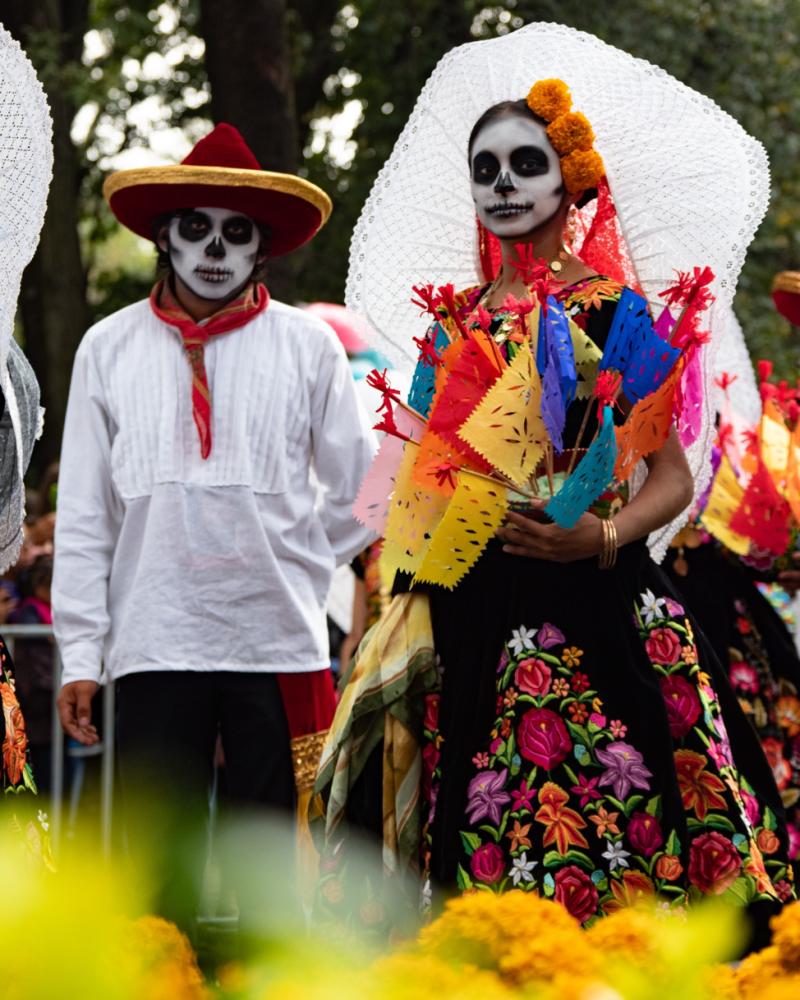The Day of the Dead is about much more than sugar skulls and likenesses of dancing skeletons. Mexico’s most colorful annual tradition is all about celebrating life while honoring those who have passed away—by welcoming their spirits back to the land of the living with Mexico City’s biggest and brightest street party. From candlelit altars to the ubiquitous orange marigolds and colorful cut paper strands that adorn the city in the days leading up to the November 2 festivities, the city becomes a technicolor dreamscape.
Naturally, this makes it a photographer’s dream. We sent AFAR Ambassador Rachel Rudwall to join in the revelry in Mexico City—along with her camera, of course. Check out Rudwall’s photo essay for inspiration on booking your trip to Mexico for next year’s festivities:
A mix of pre-Hispanic and Catholic belief systems, Día de Muertos brings together communities across Mexico to remember and celebrate loved ones who have passed. While in the U.S., the death of a loved one is solemnly mourned, in Mexico, people dance, sing, and make offerings in honor of the departed.

Backstage on the morning of Mexico City’s Day of the Dead parade, hordes of volunteers slip into brilliant costumes that they’ve spent the last several months preparing. Each group has adopted a theme for the year, many opting for traditional Mexican costumes like these twentysomethings have, colorful garb and face paint included.

In anticipation of the parade, Mexico City’s grand avenue Paseo de la Reforma shuts down, welcoming floats and costumed dance troupes. In a moment of calm before the proverbial storm, a classic car idles next to rows of cempasúchils, or marigolds, which symbolize Día de Muertos.

While the Day of the Dead is a centuries-old tradition, Mexico City’s parade was officially created three years ago. Mexican officials state that they were inspired by the Día de Muertos parade sequence in the James Bond film Spectre, thereafter creating their own grand interpretation of the festivities.

The iconic “calavera” is an often-colorful depiction of a skeleton, popularized by famed Mexican artist Diego Rivera. Calaveras grace billboards, altars of remembrance, and costumes aplenty during Day of the Dead.

Young and old come together to celebrate the people they’ve loved and lost during this weeklong celebration. Many people gather offerings of art, flowers, food, drink, and photography, and place them upon altars as dedications to their loved ones’ memories.

Día de Muertos may have deep historical roots, but Mexico City’s take on the celebration seamlessly blends the traditional and the modern. These dancers morph their country’s heritage into new reflections of cultural symbolism.

The Palacio de Bellas Artes stands to impress, no matter where you’re standing when you view it. That said, you’ll get the best views of the cultural center’s Art Nouveau exterior from above. Many tourists head to the Torre Latinoamericana for a bird’s eye view from the observation deck. However, if you want a closer perspective, you can head to the SEARS department store across the street, take the elevator to the 8thfloor, and step onto Finca Don Porfirio’s terrace for a coffee with a view.

Tucked away in the historical center of Mexico City, the Palacio de Correos de México offers a lavish lesson in design. A functioning post office since it opened in 1907, the building’s gold stairwells, paned glass ceiling, and omnipresent arches span the centuries and the styles, from Art Nouveau to Gothic, Baroque to Art Deco and beyond.

The Mercado de Medellín provides a brilliant window into of the diverse society of Mexico City, housing vendors from not only Mexico, but also Colombia, Cuba, and much of Latin America. Stop by for fresh flowers, homemade hot sauces from the Yucatán, or an armful of colorful produce. If you prefer to explore further with local experts, join chefs Jorge and Alberto of Casa Jacaranda for an adventure at the market, followed by a cooking class in their exquisitely decorated home.











